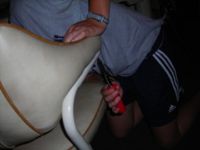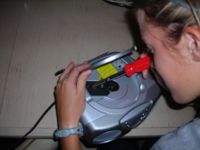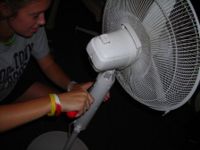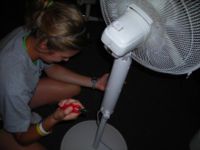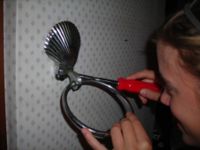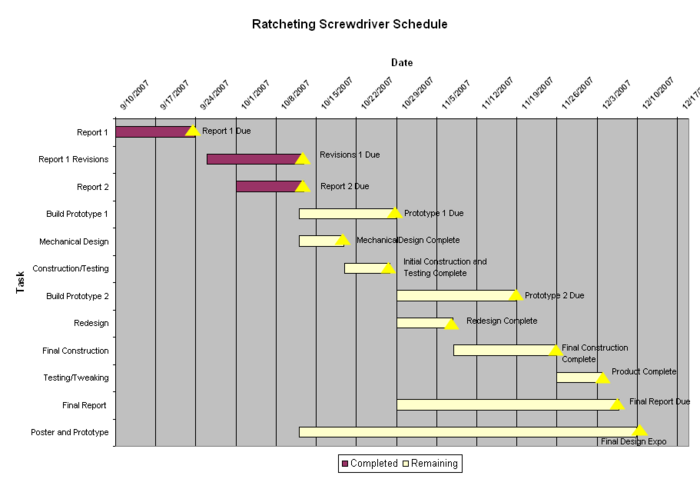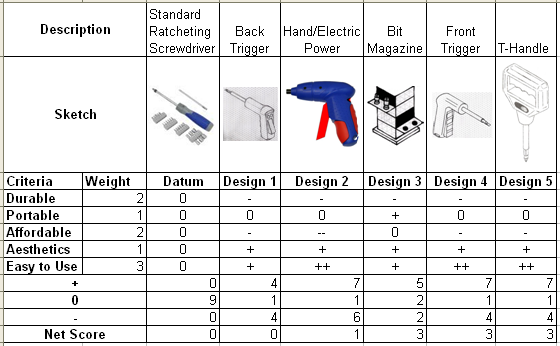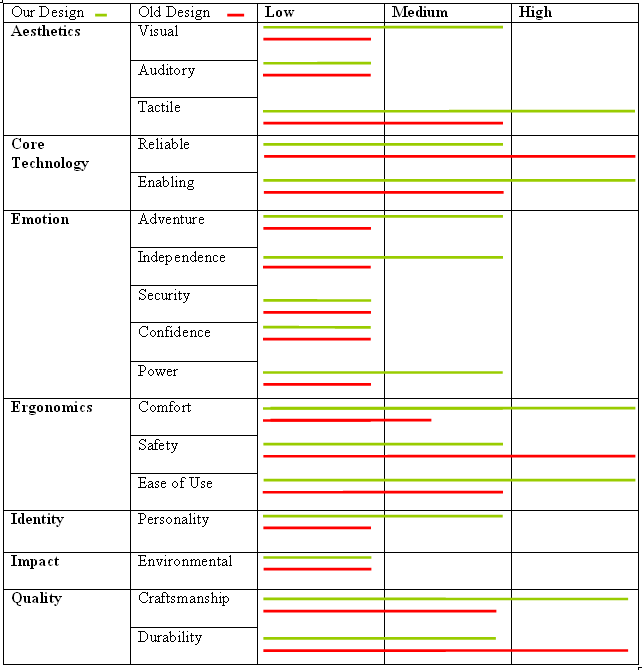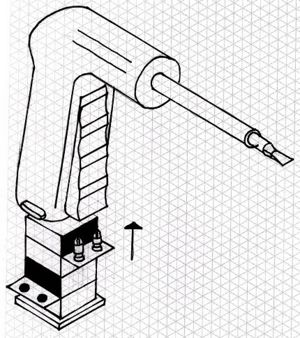Ratcheting Screwdriver Redesign
From DDL Wiki
Contents |
Market Research
We asked a number of people to use a ratcheting and non-ratcheting screwdriver on a variety of normal household items. The items tested included a CD player, a towel holder, chairs, a fan, a bedframe, a vaccum cleaner, and an airsoft gun. The idea was to provide a wide array of objects and a large sample size in order to gain a new perspective on how people use the tools and the problems they often encounter.
The users were given one of the two screwdrivers and an object to unscrew, with no other instructions. After carefully observing each of the users and interviewing them about their experiences afterwards, the most common problems experienced were:
- Applying ample pressure
- Screwing from an angle
- Determining which way the screwdriver is set up to ratchet
- Screwdriver being too long to access a screw
- Screwdriver being too short to access a screw
- Bit connection is unstable
- Bit connection point is too thick to access a screw
- Stripping screws
- Lighting issues
- Difficulties with nut/bolts
- Ratcheting loose screws
It is fairly obvious from our observations that a majority of the problems that arise are a result of complications from the size of the screwdriver. Whether it is too long or short to access a screw, or the screw is simply in an awkward space, it results in having to screw from an angle, which all users had difficulty with. We observed a number of users grow very frustrated in trying to turn these screws, and the problems with the bit connection only furthered the frustration. Bit connection is difficult and ineffective: the bit often falls off and it is not obvious when the bit is secure.
In addition, the ratcheting mechanism does not work well on loose screws. Since the user has to turn the entire screwdriver back in order to ratchet, a loose screw will simply turn along with it. This means the ratcheting mechanism is effectively useless in these situations. The main advantage of our design is that the trigger is where the ratcheting takes place. This defeats the entire problem of loose screws.
Project Schedule
The schedule for the remaining part of the project is layed out in the Gantt chart below. The milestones' occurences are denoted by a yellow triangle and have a breif description next to them. The big milestones will be the completion of Prototype 1 and Prototype 2, the Final Report, and the Design Expo. The chart is in one week increments with the red parts of the bar denoting the parts of teach task that have been completed and the cream-colored yellow represents the time remaining to complete the task. All tasks will initially be completed as a group, and will be divided up as seen fit when we are doing tasks.
Gantt Chart
Design Analysis
Pugh Chart
Value Opportunity Analysis (VOA)
VOA gives the process of encouraging new ways of thinking of ideas through envisioning the product experience in a variety of different catergories. The designer can also get a better feel for how and if the improvements made to the original design are actually improvements at all.
Aesthetics
Our design is more visually appealing and easier to hold than regular ratcheting screwdrivers. The pistol grip makes for a more comfortable handle and the trigger mechanism makes for an easier motion than rotating at the wrist. The right, left, middle ratcheting labels will be more clear and more intuitive so the user does not have trouble figuring out which side the screwdriver shaft will be turning.
Core Technology
Although ratcheting technology and hand-held drills are not a new technology combining the two will make for a new tool on the market. One problem when using a ratcheting screwdriver is that it is hard to ratchet a loose screw or one that has just started entering the hole, it will usually just spin in space due to the rotating action from the wrist and forearm that is necessary to drive the screw. A problem with the electric drill is that there is not always an outlet available and portable electric drills have battery power that is not always long lasting and take long to charge. By combining the two ideas, we can solve the two problems. There is no need for charging a drill that does not require batteries, and there is no reason to turn the handle when ratcheting with a our new design, thereby eliminating two of the problems with the conventional designs.
Emotion
Our idea gives a sense of independence because it is free from needing electricity for power and only requires hand power. It instills a sense of adventure and power because it can be taken anywhere to build and fix objects and has a very familiar pistol grip shape with a magazine loaded bit storage cartridge. Confidence and security can be experienced because the tool is durable and versatile when performing any screwing job.
Ergonomics
Ergonomics is greatly considered in our design. First the handle of our design is a very familiar pistol-grip that is easy to hold and use. The motion is then created by the user squeezing the trigger with his or her fingers. The squeezing motion is easier than the conventional rotating the hand, wrist, and forearm motion that is required to drive a screw into a hole. Worker production will also be increased because of the magazine that contains all of the bits for the drill being right on the drill; there is no longer any reason to go searching for bits or looking for a bit storage case because it will always be right with the drill.
Identity
The design we came up with has personality because it is different from everything else on the market. We have taken two well accepted ideas and combined them to make an even better idea. The magazine loaded bit storage system is also very unique, other srewdrivers and drills have storae systems but none as cool as a magazine loaded bit storage system.
Impact
The battery of the electric drill has negative environmental effects that can be eliminated through the use of an alternative clean power source; that is where hand power comes into play. The hand power that drives our design will eliminate the need for a battery and thereby have a positive environmental impact.
Quality
Our product should meet customer satisaction to a greater degree because of its ease of use and feature that will actually drive loose screws into a hole rather than just turn them back and forth like conventional ratcheting screwdrivers do. Our design is not as durable as the conventional ratcheting screwdriver because of the additional moving parts. However, these additional moving parts are necessary to increase the ease of use, functionality, and versatility of the ratcheting screwdriver, which we believe is a fair tradeoff. Our product will be quality made.
Final Design
Market research has shown some issues with the current design of a ratcheting screwdriver. Our proposed choice of redesigns consists of several key features meant to improve upon the original design. The new design will be easier to use, the controls will be more intuitive, and the product will be more versatile than the previous design.
The first feature being redesigned is the handle. The existing design, while tried and true, has several flaws. Gripping the handle requires an unnatural hand position and quickly leads to fatigue after repeated use. The new design is much more ergonomic. The pistol grip is a much more natural position and since the device is not operated by a twisting motion the probability of fatigue is greatly reduced. The new handle design also promotes the use of downward pressure and will therefore reduce the number of stripped screw heads.
Included with this new handle design is a new operating mechanism. Previously the screwdriver has been operated by turning the handle with the operator's hand and wrist. The new design is operated by a hand trigger. A simple squeeze of ones hand is all that it takes to operate. This should increase the time before fatigue sets in compared to the old design for a ratcheting screwdriver. It it also an improvement over the power drill in several areas. First off there is no battery to worry about. The new design is always ready to be used. The new design is also variable speed, based on the quickness of the operators squeeze, unlike the comparable power drill which only has one speed.
It was also found that the switch is an area in need of improvement. The switch mechanism for the ratchet can be confusing to use and needs two hands for operation. The new design has a clearly illustrated switch so that the operator can quickly recognize what setting the screwdriver is on. It is also easily operated with only the thumb of the hand holding onto the pistol grip.
The new ratcheting mechanism also solves the major problem of a loose screw. Whether it be installing or removing. The old design uses the resistance of the screw to hold the shaft in place, thus rendering the mechanism inoperable when the screw is very loose. The new design relies on an internal resistance instead.
The last feature being redesigned is the storage for bits. Often this is a separate piece from the screwdriver itself. But when incorporated it is usually unwieldy, unsightly, and inefficient. The new design is that of a magazine hidden in the handle of the pistol grip effectively solving the issues with old designs.

